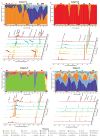Temporal dynamics of the human vaginal microbiota
- PMID: 22553250
- PMCID: PMC3722878
- DOI: 10.1126/scitranslmed.3003605
Temporal dynamics of the human vaginal microbiota
Abstract
Elucidating the factors that impinge on the stability of bacterial communities in the vagina may help in predicting the risk of diseases that affect women's health. Here, we describe the temporal dynamics of the composition of vaginal bacterial communities in 32 reproductive-age women over a 16-week period. The analysis revealed the dynamics of five major classes of bacterial communities and showed that some communities change markedly over short time periods, whereas others are relatively stable. Modeling community stability using new quantitative measures indicates that deviation from stability correlates with time in the menstrual cycle, bacterial community composition, and sexual activity. The women studied are healthy; thus, it appears that neither variation in community composition per se nor higher levels of observed diversity (co-dominance) are necessarily indicative of dysbiosis.
Conflict of interest statement
Figures





Comment in
-
Complexities of the uniquely human vagina.Sci Transl Med. 2012 May 2;4(132):132fs11. doi: 10.1126/scitranslmed.3003944. Sci Transl Med. 2012. PMID: 22553249
References
-
- Sobel JD. Is There a Protective Role for Vaginal Flora? Current infectious disease reports. 1999;1:379. - PubMed
-
- Witkin SS, Linhares IM, Giraldo P. Bacterial flora of the female genital tract: function and immune regulation. Best Pract Res Clin Obstet Gynaecol. 2007;21:347. - PubMed
-
- Yamamoto T, Zhou X, Williams CJ, Hochwalt A, Forney LJ. Bacterial populations in the vaginas of healthy adolescent women. J Pediatr Adolesc Gynecol. 2009;22:11. - PubMed
-
- Dunstan PK, Johnson CR. Linking richness, community variability, and invasion resistance with patch size. Ecology. 2006;87:2842. - PubMed
Publication types
MeSH terms
Grants and funding
LinkOut - more resources
Full Text Sources
Other Literature Sources
Medical

